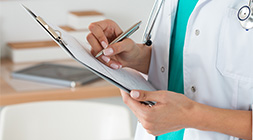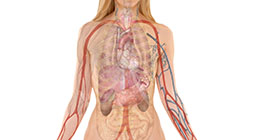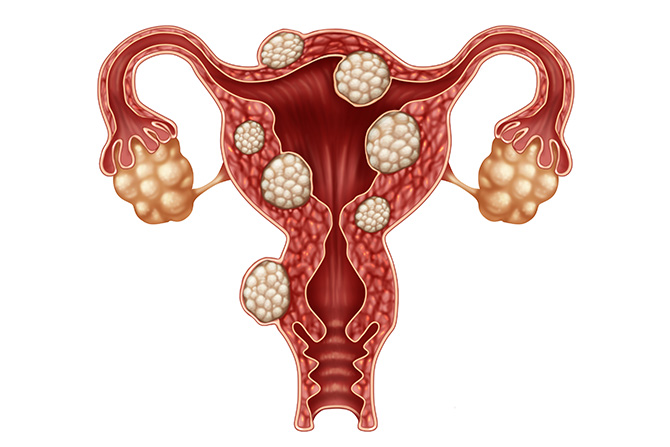Overview
Types of Fibroids
Symptoms
Causes
Prescription
Health Tips
Uterine fibroids (or myomas) are round, firm, benign growths on either of the interior or exterior walls of the uterus. These growths are comprised of connective tissue and smooth muscle bundles and may be small (like a pea) or large (like a grapefruit), but the average size is like an egg. They usually appear in groups, not singularly, and sometimes they affect the cervix as well. Most fibroids grow slowly; if they grow quickly, they could be malignant.
Roughly 20 to 30 percent of women over the age of 35 will have fibroids at some time. They have a tendency to form eight to ten years prior to menopause. Fibroids are affected by estrogen and progesterone levels. Because of this, growths tend to shrink at menopause. However, they may also increase in size at menopause and become malignant.
For many women with fibroids, the approach conventional medicine often takes is to recommend a hysterectomy. However, removing the entire uterus because of fibroids is an extreme measure since a skilled surgeon can remove fibroids without damaging the uterus (called a myomectomy). In many cases surgically removed tumors will return if lifestyle changes are not adopted. The drug, Lupron, has been used to promote menopause, causing fibroids to shrink small enough for surgical removal.
Naturopathic doctor, Tori Hudson, ND, has stated that in her practice, “Fibroids are the most difficult cases to treat with naturopathy, although there are notable isolated success stories.” Her aim is to treat the symptoms, attempt to control the condition until menopause, and identify if the situation has progressed to where conventional treatment is appropriate. In North America over 750,000 hysterectomies are performed annually, and fibroids are the main reason for this surgery.
Types of Fibroids
Intramural: Grow in the walls of the uterus and are the most common type
Submucosal: Grow near the interior cavity of the uterus and can cause increased bleeding
Subserosal: Grow on the exterior of the uterus
Pedunculated: Can grow inside or outside of the uterus on small stalks
Cervical: Rare type, located in the cervix
Prolapsed: A cervical fibroid passing through the cervix into the vagina
Symptoms
Some women are surprised to learn during a pelvic examination that they have fibroids, as they have experienced no symptoms, even if they have a rather large growth. Complications can occur if the location or weight of the fibroids puts pressure on the bowels, bladder, or urethra, causing obstructions. Urinary function may be compromised and the uterus may drop years later when the pelvic support weakens. Other symptoms include:
- Anemia and fatigue due to excess menstruation
- Frequent urination
- Heavy, irregular periods containing blood clots
- Mid-cycle bleeding
- Painful cramping during periods
- Pelvic and lower back pain
- Problems with bowel movements
- Swollen or enlarged abdomen
- Trouble conceiving, miscarriage, premature delivery, increased chances of cesarean section or severe loss of blood after the birth
- Vaginal discharge, pain or bleeding with intercourse
Causes
A mix of hormonal and genetic factors are likely as the root cause. Research suggests a genetic component in up to 70 percent of cases. Studies have shown that women who eat a diet high in red meat and ham have more uterine fibroids than those who eat a diet rich in fruits and vegetables. Both estrogen and progesterone can promote fibroid growth. Women exposed to endocrine disruptors and those under severe stress are often estrogen dominant.
Bowel toxicity, liver congestion, undiagnosed clinical or functional hypothyroidism are all possible factors.
High blood pressure has also been linked to uterine fibroid growth. Women with hypertension are approximately 24 percentage more likely to suffer uterine fibroids.
Prescription for Health
| Nutrient | Dosage | Action |
|---|---|---|
| Calcium D-glucarate* | 300 mg | Important for healthy metabolism of estrogen; supports normal cell growth |
| Curcumin (95% curcumin)* | 100 mg | Prevents abnormal cell growth; detoxifies cancer-causing form of estrogen |
| Indole-3-carbinol* | 300 mg | Stops healthy estrogen from converting into the cancer-causing form
Has been shown to reverse abnormal PAP tests within three menstrual cycles |
| Green tea extract* | 200 mg | Protects against abnormal cell growth; detoxifies excess estrogens |
| Rosemary extract* | 50 mg | Reduces tumor formation; antioxidant |
| Di-indolylmethane (DIM)* | 100 mg | Antioxidant; reduces risk of cancer |
| Sulfpraphane* | 400 mcg | Reduces risk of cancer; stops abnormal cell growth |
| Micronized, microencapsulated iron pyrophosphate III | 10-30 mg daily if you have heavy periods due to the fibroids | Does not constipate; enhances iron |
| Shepherd’s Purse Tincture |
20 drops per hour during heavy periods |
Stops heavy bleeding and clotting |
| Borage Oil | 2000 mg daily | Anti-inflammatory; controls negative prostaglandins involved in pain and inflammation |
| Vitamin K2 MK7 | 100 mcg daily | Stops heavy bleeding |
Diet
Reduce consumption of meat and dairy products as this will help avoid excess estrogen. When eating dairy and meat, opt for organic and grass-fed products. A plant-based organic diet is best for those with uterine fibroids. With the exception of the Clean Fifteen, conventional produce, especially the Dirty Dozen, are high in xenoestrogens from pesticides. Concentrate on whole grains, fresh fruits and vegetables.
Consume liver-friendly foods such as kale, carrots, beets, artichokes, lemons, onions, garlic, leeks and members of the cabbage family (broccoli, Brussels sprouts, cauliflower).
Omega-3 fatty acids from wild fishes, fish oils, nut and seeds should also be included to help reduce inflammation.
Avoid processed foods, refined carbohydrates, and added sugars. These foods will cause blood sugar levels to spike and may affect uterine fibroids.
Avoid alcohol and caffeine. Alcohol interferes with liver function and caffeine exacerbates the growths.
Lifestyle
Use ‘clean’ body care and home cleaning products that are free of contaminants instead of the conventional brand products which are often full of endocrine disrupting chemicals. Check product safety on EWG’s Skin Deep site for best options.
Chronic stress plays havoc on hormone balance and can lead to an excess of estrogen. Prioritize reducing stress, get plenty of sleep, and practice relaxation techniques such as meditation, visualization, biofeedback, qigong, yoga, and deep breathing exercises.
Maintaining a healthy weight is important. Being overweight can increase the effects of estrogen on the uterus. Exercise regularly to burn calories, improve circulation and help the body’s detoxification and elimination processes.
Castor oil packs are excellent at controlling pain. Take six pieces of flannel soaked in castor oil (damp but not dripping) about the size of the area needed to treat. Place them over the area and put a towel-wrapped hot water bottle on top. Use the pack two to four times per week.
Health Tips to Enhance Healing
- Avoid alcohol
- Avoid or reduce dairy products, caffeine (including medications), sugar, chocolate, coffee, caffeinated tea, and soft drinks.
- Avoid makeup, body care products, and house cleaning products containing xenoestrogens.
- Avoid endocrine disruptors found in Teflon, BPA-containing plastics, and personal care products.
- Do not take estrogen medications, including the birth control pill.
- Follow a vegetarian diet and avoid meat products (do not exclude fish). Concentrate on whole grains, fresh fruits and vegetables.
- Choose organic foods whenever possible.
- Increase fiber intake. Fiber carries estrogen out of the body.
- Lose extra pounds
- Reduce stress and get plenty of sleep
- There are many beneficial herbs to aid in detoxification; look for products containing milk thistle (used for a short term) and dandelion root.











